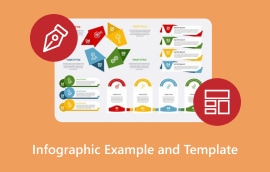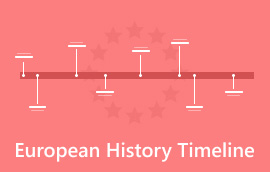ਆਰਟ ਹਿਸਟਰੀ ਟਾਈਮਲਾਈਨ ਦੁਆਰਾ ਇੱਕ ਵਿਜ਼ੂਅਲ ਯਾਤਰਾ: ਕਹਾਣੀ ਕਿਵੇਂ ਸ਼ੁਰੂ ਹੁੰਦੀ ਹੈ
ਕਲਾ ਇਤਿਹਾਸ ਇੱਕ ਵੱਡਾ ਅਤੇ ਗੁੰਝਲਦਾਰ ਖੇਤਰ ਹੈ ਜੋ ਬਹੁਤ ਸਾਰੇ ਸਮੇਂ ਅਤੇ ਸਥਾਨਾਂ ਨੂੰ ਕਵਰ ਕਰਦਾ ਹੈ। ਕਲਾ ਇਤਿਹਾਸ ਦੀ ਸਮਾਂ-ਰੇਖਾ ਬਣਾਉਣਾ ਇਹ ਸਮਝਣ ਵਿੱਚ ਬਹੁਤ ਮਦਦਗਾਰ ਹੋ ਸਕਦਾ ਹੈ ਕਿ ਸਾਲਾਂ ਵਿੱਚ ਕਲਾ ਕਿਵੇਂ ਬਦਲੀ ਹੈ। ਤੁਸੀਂ ਦੇਖ ਸਕਦੇ ਹੋ ਕਿ ਕਿਵੇਂ ਕਲਾ ਇਤਿਹਾਸ ਦੌਰਾਨ ਮਹੱਤਵਪੂਰਨ ਘਟਨਾਵਾਂ, ਸ਼ੈਲੀਆਂ ਅਤੇ ਕਲਾਕਾਰਾਂ ਨੂੰ ਸਭ ਤੋਂ ਪੁਰਾਣੇ ਤੋਂ ਨਵੇਂ ਤੱਕ ਕ੍ਰਮ ਵਿੱਚ ਰੱਖ ਕੇ ਜੁੜੀ ਹੋਈ ਹੈ। ਇਹ ਵੇਰਵਿਆਂ, ਸਪਾਟ ਪੈਟਰਨਾਂ ਨੂੰ ਛਾਂਟਣਾ ਅਤੇ ਇਹ ਦੇਖਣਾ ਆਸਾਨ ਬਣਾਉਂਦਾ ਹੈ ਕਿ ਕੀ ਕਲਾ ਯੁੱਗ ਜੁੜੇ ਹੋਏ ਹਨ। ਇਹ ਸਮੀਖਿਆ ਤੁਹਾਨੂੰ ਦਿਖਾਏਗੀ ਕਲਾ ਇਤਿਹਾਸ ਟਾਈਮਲਾਈਨ MindOnMap ਨਾਲ। ਆਉ ਇਸ ਕਲਾ ਇਤਿਹਾਸ ਦੇ ਸਾਹਸ ਨੂੰ ਸ਼ੁਰੂ ਕਰੀਏ ਅਤੇ ਦੇਖਦੇ ਹਾਂ ਕਿ ਕਿਵੇਂ MindOnMap ਇੱਕ ਸਮਾਂਰੇਖਾ ਬਣਾਉਣ ਵਿੱਚ ਤੁਹਾਡੀ ਮਦਦ ਕਰ ਸਕਦਾ ਹੈ ਜੋ ਦਿਲਚਸਪ ਅਤੇ ਤੱਥਾਂ ਨਾਲ ਭਰਪੂਰ ਹੋਵੇ।

- ਭਾਗ 1. ਕਲਾ ਇਤਿਹਾਸ ਟਾਈਮਲਾਈਨ
- ਭਾਗ 2. ਵਧੀਆ ਕਲਾ ਇਤਿਹਾਸ ਟਾਈਮਲਾਈਨ ਸਿਰਜਣਹਾਰ
- ਭਾਗ 3. ਕਲਾ ਇਤਿਹਾਸ ਦੀ ਸਮਾਂਰੇਖਾ ਬਾਰੇ ਅਕਸਰ ਪੁੱਛੇ ਜਾਂਦੇ ਸਵਾਲ
ਭਾਗ 1. ਕਲਾ ਇਤਿਹਾਸ ਟਾਈਮਲਾਈਨ
ਕਲਾ ਅੰਦੋਲਨਾਂ ਦੀ ਸਮਾਂਰੇਖਾ ਇੱਕ ਵੱਡਾ ਅਤੇ ਗੁੰਝਲਦਾਰ ਖੇਤਰ ਹੈ ਜੋ ਸੈਂਕੜੇ ਸਾਲਾਂ ਅਤੇ ਸੰਸਾਰ ਦੇ ਵੱਖ-ਵੱਖ ਹਿੱਸਿਆਂ ਨੂੰ ਕਵਰ ਕਰਦਾ ਹੈ। ਇੱਕ ਵਿਜ਼ੂਅਲ ਟਾਈਮਲਾਈਨ ਬਣਾਉਣਾ ਇਹ ਸਮਝਣ ਵਿੱਚ ਬਹੁਤ ਮਦਦਗਾਰ ਹੋ ਸਕਦਾ ਹੈ ਕਿ ਸਮੇਂ ਦੇ ਨਾਲ ਕਲਾ ਕਿਵੇਂ ਬਦਲ ਗਈ ਹੈ। ਤੁਸੀਂ ਮਹੱਤਵਪੂਰਨ ਪਲਾਂ, ਸ਼ੈਲੀਆਂ ਅਤੇ ਕਲਾਕਾਰਾਂ ਨੂੰ ਸਭ ਤੋਂ ਪੁਰਾਣੇ ਤੋਂ ਨਵੇਂ ਤੱਕ ਕ੍ਰਮ ਵਿੱਚ ਰੱਖ ਕੇ ਦੇਖ ਸਕਦੇ ਹੋ ਕਿ ਕਲਾ ਇਤਿਹਾਸ ਵਿੱਚ ਕਿਵੇਂ ਜੁੜੀ ਹੋਈ ਹੈ। ਇਹ ਸਮੀਖਿਆ ਕਲਾ ਦੇ ਸਮੇਂ ਦੇ ਇਤਿਹਾਸ ਨੂੰ ਵੇਖੇਗੀ।
ਕਲਾ ਯੁੱਗ ਟਾਈਮਲਾਈਨ
ਪੂਰਵ-ਇਤਿਹਾਸਕ ਕਲਾ (40,000 - 4,000 BCE)
ਗੁਫਾ ਚਿੱਤਰਕਾਰੀ: ਪਹਿਲੀ ਕਲਾ ਜਿਸ ਬਾਰੇ ਅਸੀਂ ਜਾਣਦੇ ਹਾਂ, ਜਿਵੇਂ ਕਿ ਲਾਸਕਾਕਸ, ਫਰਾਂਸ ਵਿੱਚ, ਜਾਨਵਰਾਂ ਅਤੇ ਲੋਕਾਂ ਨੂੰ ਦਿਖਾਇਆ ਗਿਆ।
ਸਟੋਨਹੇਂਜ ਵਰਗੀਆਂ ਥਾਵਾਂ 'ਤੇ ਪੈਟਰੋਗਲਾਈਫਸ ਅਤੇ ਮੈਗੈਲਿਥ ਚੱਟਾਨਾਂ ਦੀ ਨੱਕਾਸ਼ੀ ਹਨ। ਉਹ ਧਾਰਮਿਕ ਅਤੇ ਰਸਮੀ ਕਾਰਨਾਂ ਕਰਕੇ ਹਨ।
ਪ੍ਰਾਚੀਨ ਕਲਾ (4,000 BCE - 400 CE)
ਮਿਸਰੀ ਕਲਾ: ਸਾਡੇ ਮਰਨ ਤੋਂ ਬਾਅਦ ਕੀ ਹੁੰਦਾ ਹੈ, ਇਸ ਬਾਰੇ ਸਭ ਕੁਝ, ਕਬਰ ਦੀਆਂ ਤਸਵੀਰਾਂ, ਹਾਇਰੋਗਲਿਫਸ, ਅਤੇ ਸਪਿੰਕਸ ਵਰਗੀਆਂ ਵੱਡੀਆਂ ਮੂਰਤੀਆਂ ਵਰਗੀਆਂ ਸ਼ਾਨਦਾਰ ਚੀਜ਼ਾਂ ਨਾਲ।
ਮੇਸੋਪੋਟੇਮੀਅਨ ਕਲਾ: ਇਸ ਨੇ ਜ਼ਿਗਗੁਰਟਸ, ਸਿਲੰਡਰ ਸੀਲਾਂ ਅਤੇ ਗੁੰਝਲਦਾਰ ਨੱਕਾਸ਼ੀ ਦਿਖਾਈ। ਉਹ ਬਹੁਤ ਸਾਰੇ ਦੇਵਤਿਆਂ ਨੂੰ ਮੰਨਦੇ ਸਨ।
ਯੂਨਾਨੀ ਅਤੇ ਰੋਮਨ ਕਲਾ ਨੇ ਇਸ ਨੂੰ ਅਸਲੀ ਰੱਖਿਆ ਅਤੇ ਲੋਕਾਂ 'ਤੇ ਕੇਂਦ੍ਰਿਤ ਕੀਤਾ, ਮੂਰਤੀਆਂ, ਮਿੱਟੀ ਦੇ ਬਰਤਨ, ਅਤੇ ਇਮਾਰਤਾਂ, ਜਿਵੇਂ ਕਿ ਪਾਰਥੇਨਨ ਅਤੇ ਕੋਲੋਸੀਅਮ ਵਿੱਚ ਵੱਡੇ ਸੁਧਾਰ ਕੀਤੇ ਗਏ ਹਨ।
ਮੱਧਕਾਲੀ ਕਲਾ (400 - 1400 CE)
ਇਤਾਲਵੀ ਪੁਨਰਜਾਗਰਣ: ਇਸ ਅੰਦੋਲਨ ਨੇ ਪੁਰਾਣੇ ਸਕੂਲ ਦੇ ਥੀਮਾਂ ਦੀ ਵਾਪਸੀ ਨੂੰ ਜਨਮ ਦਿੱਤਾ, ਜਿਵੇਂ ਕਿ ਕਲਾ ਵਿੱਚ ਦ੍ਰਿਸ਼ਟੀਕੋਣ ਅਤੇ ਮਨੁੱਖੀ ਸਰੀਰ ਨੂੰ ਕਿਵੇਂ ਇਕੱਠਾ ਕੀਤਾ ਜਾਂਦਾ ਹੈ ਇਸ ਬਾਰੇ ਸਿੱਖਣਾ। ਇਸ ਲਹਿਰ ਦੇ ਵੱਡੇ ਨਾਂ ਲਿਓਨਾਰਡੋ ਦਾ ਵਿੰਚੀ, ਮਾਈਕਲਐਂਜਲੋ ਅਤੇ ਰਾਫੇਲ ਹਨ।
ਉੱਤਰੀ ਪੁਨਰਜਾਗਰਣ: ਜੈਨ ਵੈਨ ਆਈਕ ਅਤੇ ਅਲਬਰੈਕਟ ਡਯੂਰਰ ਵਰਗੇ ਕਲਾਕਾਰਾਂ ਦੇ ਨਾਲ ਤੇਲ ਪੇਂਟਾਂ ਨਾਲ ਪੇਂਟਿੰਗਾਂ ਨੂੰ ਸੁਪਰ ਯਥਾਰਥਵਾਦੀ ਬਣਾਉਣ 'ਤੇ ਕੇਂਦ੍ਰਤ ਕੀਤਾ ਗਿਆ।
ਵਿਵਹਾਰਵਾਦ, ਜੋ ਬਾਅਦ ਵਿੱਚ ਪੁਨਰਜਾਗਰਣ ਵਿੱਚ ਪ੍ਰਗਟ ਹੋਇਆ ਸੀ, ਇਸਦੇ ਖਿੱਚੇ ਹੋਏ ਆਕਾਰਾਂ, ਓਵਰ-ਦੀ-ਟੌਪ ਪੋਜ਼, ਅਤੇ ਗੁੰਝਲਦਾਰ ਲੇਆਉਟ ਲਈ ਜਾਣਿਆ ਜਾਂਦਾ ਹੈ।
ਬਾਰੋਕ ਕਲਾ (1600 - 1750 ਈ.)
ਭਾਵਨਾਤਮਕ ਸ਼ਕਤੀ: ਬੈਰੋਕ ਕਲਾ ਬਹੁਤ ਭਾਵਨਾਤਮਕ ਅਤੇ ਸ਼ਾਨਦਾਰ ਹੋਣ ਅਤੇ ਰੌਸ਼ਨੀ ਅਤੇ ਹਨੇਰੇ (ਚਿਆਰੋਸਕਰੋ) ਨਾਲ ਖੇਡਣ ਲਈ ਮਸ਼ਹੂਰ ਹੈ। ਕਾਰਵਾਗਜੀਓ, ਰੇਮਬ੍ਰਾਂਡਟ ਅਤੇ ਬਰਨੀਨੀ ਵਰਗੇ ਕਲਾਕਾਰ ਇਸ ਸ਼ੈਲੀ ਦੇ ਵਧੀਆ ਉਦਾਹਰਣ ਹਨ।
ਫੈਨਸੀ ਬਿਲਡਿੰਗਾਂ: ਬਾਰੋਕ ਇਮਾਰਤਾਂ ਸਭ ਕੁਝ ਸਜਾਵਟੀ ਹੋਣ ਬਾਰੇ ਹਨ, ਵੱਡੀਆਂ ਪੌੜੀਆਂ, ਫੈਨਸੀ ਸੀਲਿੰਗ ਪੇਂਟਿੰਗਾਂ, ਅਤੇ ਬਹੁਤ ਸਾਰੇ ਸੋਨੇ ਦੇ ਪੱਤੇ ਦੇ ਨਾਲ।
ਰੋਕੋਕੋ ਆਰਟ (1700 - 1770 ਈ.)
ਵਧੀਆ ਅਤੇ ਫੈਂਸੀ: ਰੋਕੋਕੋ ਕਲਾ ਬਾਰੋਕ ਕਲਾ ਨਾਲੋਂ ਸਰਲ, ਮਜ਼ੇਦਾਰ ਅਤੇ ਸ਼ਾਨਦਾਰ ਹੈ। ਇਹ ਨਰਮ ਪੇਸਟਲ ਰੰਗ, ਅਸਮਾਨ ਡਿਜ਼ਾਈਨ, ਅਤੇ ਪਿਆਰ ਅਤੇ ਕੁਦਰਤ ਨੂੰ ਮੁੱਖ ਥੀਮ ਵਜੋਂ ਪੇਸ਼ ਕਰਦਾ ਹੈ। ਮਸ਼ਹੂਰ ਰੋਕੋਕੋ ਕਲਾਕਾਰ ਫ੍ਰਾਂਕੋਇਸ ਬਾਊਚਰ ਅਤੇ ਜੀਨ-ਆਨਰੇ ਫਰੈਗੋਨਾਰਡ ਹਨ।
ਨਿਓਕਲਾਸਿਸਿਜ਼ਮ (1750 - 1850 ਈ.)
ਪੁਰਾਣੇ ਸਕੂਲ ਦੇ ਵਿਚਾਰਾਂ ਵੱਲ ਵਾਪਸ ਜਾਣਾ: ਪੁਰਾਣੇ ਖੰਡਰਾਂ ਨੂੰ ਲੱਭਣ ਤੋਂ ਬਾਅਦ, ਨਿਓਕਲਾਸਿਸਿਜ਼ਮ ਨੇ ਚੀਜ਼ਾਂ ਨੂੰ ਸਰਲ ਅਤੇ ਸੰਤੁਲਿਤ ਰੱਖਣ ਅਤੇ ਪੁਰਾਣੀਆਂ ਕਹਾਣੀਆਂ ਅਤੇ ਇਤਿਹਾਸ ਦੇ ਵਿਸ਼ਿਆਂ 'ਤੇ ਧਿਆਨ ਦਿੱਤਾ। ਜੈਕ-ਲੁਈਸ ਡੇਵਿਡ ਅਤੇ ਐਂਟੋਨੀਓ ਕੈਨੋਵਾ ਇਸ ਲਹਿਰ ਦੇ ਵੱਡੇ ਨਾਂ ਸਨ।
ਰੋਮਾਂਸਵਾਦ (1800 - 1850 ਈ.)
ਰੋਮਾਂਸਵਾਦ ਆਪਣੇ ਆਪ ਹੋਣ, ਡੂੰਘਾਈ ਨਾਲ ਮਹਿਸੂਸ ਕਰਨ ਅਤੇ ਕੁਦਰਤ ਦੀ ਸੁੰਦਰਤਾ ਨੂੰ ਪਿਆਰ ਕਰਨ ਬਾਰੇ ਸੀ। ਇਹ ਅਕਸਰ ਤੀਬਰ ਅਤੇ ਵਿਲੱਖਣ ਦ੍ਰਿਸ਼ ਦਿਖਾਉਂਦੀ ਸੀ। ਕੈਸਪਰ ਡੇਵਿਡ ਫ੍ਰੀਡਰਿਕ ਅਤੇ ਫਰਾਂਸਿਸਕੋ ਗੋਯਾ ਵਰਗੇ ਮਸ਼ਹੂਰ ਕਲਾਕਾਰ ਇਸ 'ਤੇ ਵੱਡੇ ਸਨ।
ਯਥਾਰਥਵਾਦ (1848 - 1900 ਈ.)
ਸਾਧਾਰਨ ਜੀਵਨ ਨੂੰ ਦਰਸਾਉਣਾ: ਯਥਾਰਥਵਾਦ ਫੈਨਸੀ, ਸੁਪਨਮਈ ਚੀਜ਼ਾਂ ਤੋਂ ਦੂਰ ਹੋ ਗਿਆ ਅਤੇ ਇਸ ਦੀ ਬਜਾਏ ਅਸਲ-ਜੀਵਨ ਦੇ ਪਲਾਂ ਨੂੰ ਸੱਚਾਈ ਨਾਲ ਦਿਖਾਉਣਾ ਚਾਹੁੰਦਾ ਸੀ ਅਤੇ ਬਿਲਕੁਲ ਉਹ ਕਿਵੇਂ ਸਨ। Gustave Courbet ਅਤੇ Jean-Francois Millet ਵਰਗੇ ਕਲਾਕਾਰਾਂ ਨੇ ਨਿਯਮਤ ਲੋਕਾਂ ਦੇ ਰੋਜ਼ਾਨਾ ਜੀਵਨ ਵੱਲ ਧਿਆਨ ਦਿੱਤਾ।
ਪ੍ਰਭਾਵਵਾਦ (1860 - 1886 ਈ.)
ਰੋਸ਼ਨੀ ਅਤੇ ਰੰਗ: ਪ੍ਰਭਾਵਵਾਦੀਆਂ ਦਾ ਉਦੇਸ਼ ਇਹ ਦਿਖਾਉਣਾ ਸੀ ਕਿ ਰੌਸ਼ਨੀ ਅਤੇ ਹਵਾ ਕਿਵੇਂ ਮਹਿਸੂਸ ਹੁੰਦੀ ਹੈ, ਆਮ ਤੌਰ 'ਤੇ ਬਾਹਰ ਚਿੱਤਰਕਾਰੀ ਕਰਦੇ ਹਨ। ਤੇਜ਼ ਬੁਰਸ਼ਸਟ੍ਰੋਕ ਅਤੇ ਚਮਕਦਾਰ ਰੰਗਾਂ ਦੀ ਵਰਤੋਂ ਕਰਦੇ ਹੋਏ ਕਲਾਉਡ ਮੋਨੇਟ, ਪੀਅਰੇ-ਅਗਸਤ ਰੇਨੋਇਰ, ਅਤੇ ਐਡਗਰ ਡੇਗਾਸ ਮੁੱਖ ਸਨ।
ਪੋਸਟ-ਪ੍ਰਭਾਵਵਾਦ (1886 - 1905 ਈ.)
ਪ੍ਰਭਾਵਵਾਦ ਤੋਂ ਪਰੇ ਜਾਣਾ: ਵਿੰਸੇਂਟ ਵੈਨ ਗੌਗ, ਪੌਲ ਸੇਜ਼ਾਨ, ਅਤੇ ਜੌਰਜਸ ਸਿਊਰਾਟ ਵਰਗੇ ਕਲਾਕਾਰਾਂ ਨੇ ਬਣਤਰ, ਸ਼ਕਲ, ਅਤੇ ਉਹਨਾਂ ਨੇ ਆਪਣੀ ਕਲਾ ਨੂੰ ਕਿਵੇਂ ਮਹਿਸੂਸ ਕੀਤਾ, ਜਿਸ ਨਾਲ ਪੇਂਟਿੰਗ ਦੇ ਇੱਕ ਹੋਰ ਅਮੂਰਤ ਤਰੀਕੇ ਵੱਲ ਵੱਧ ਧਿਆਨ ਦੇ ਕੇ ਪ੍ਰਭਾਵਵਾਦ ਨੂੰ ਬਣਾਇਆ ਗਿਆ।
ਆਧੁਨਿਕ ਕਲਾ (1900 - 1970 CE)
ਕਿਊਬਿਜ਼ਮ: ਪਾਬਲੋ ਪਿਕਾਸੋ ਅਤੇ ਜਾਰਜਸ ਬ੍ਰੇਕ ਦੁਆਰਾ ਸ਼ੁਰੂ ਕੀਤਾ ਗਿਆ, ਕਿਊਬਿਜ਼ਮ ਵਸਤੂਆਂ ਨੂੰ ਸਧਾਰਨ ਆਕਾਰਾਂ ਵਿੱਚ ਵੰਡਦਾ ਹੈ, ਇੱਕ ਤਸਵੀਰ ਵਿੱਚ ਵੱਖੋ-ਵੱਖਰੇ ਦ੍ਰਿਸ਼ ਦਿਖਾਉਂਦੇ ਹਨ।
ਭਵਿੱਖਵਾਦ: ਸਭ ਕੁਝ ਤੇਜ਼ ਐਕਸ਼ਨ, ਤਕਨੀਕ, ਅਤੇ ਚਲਦੇ ਦ੍ਰਿਸ਼ਾਂ ਬਾਰੇ, ਆਮ ਤੌਰ 'ਤੇ ਸ਼ਹਿਰੀ ਜੀਵਨ ਬਾਰੇ।
ਅਤਿ-ਯਥਾਰਥਵਾਦ: ਇਹ ਲੁਕਵੇਂ ਮਨ ਅਤੇ ਸੁਪਨਮਈ ਚਿੱਤਰਾਂ 'ਤੇ ਕੇਂਦਰਿਤ ਹੈ। ਸਲਵਾਡੋਰ ਡਾਲੀ ਅਤੇ ਰੇਨੇ ਮੈਗ੍ਰਿਟ ਮਸ਼ਹੂਰ ਉਦਾਹਰਣ ਹਨ।
ਐਬਸਟਰੈਕਟ ਐਕਸਪ੍ਰੈਸ਼ਨਿਜ਼ਮ: ਅਮਰੀਕਾ ਵਿੱਚ ਦੂਜੇ ਵਿਸ਼ਵ ਯੁੱਧ ਤੋਂ ਬਾਅਦ ਪੈਦਾ ਹੋਇਆ, ਇਹ ਆਪਣੇ ਸੁਤੰਤਰ ਪ੍ਰਵਾਹ, ਅਮੂਰਤ ਆਕਾਰਾਂ ਅਤੇ ਕਲਾਕਾਰ ਦੀਆਂ ਭਾਵਨਾਵਾਂ 'ਤੇ ਧਿਆਨ ਕੇਂਦਰਿਤ ਕਰਨ ਲਈ ਜਾਣਿਆ ਜਾਂਦਾ ਹੈ। ਜੈਕਸਨ ਪੋਲਕ ਅਤੇ ਮਾਰਕ ਰੋਥਕੋ ਇਸ ਸ਼ੈਲੀ ਦੇ ਮਸ਼ਹੂਰ ਕਲਾਕਾਰ ਹਨ।
ਸਮਕਾਲੀ ਕਲਾ (1970 - ਵਰਤਮਾਨ)
ਵਿਭਿੰਨ ਅਤੇ ਵਿਸ਼ਵਵਿਆਪੀ: ਆਧੁਨਿਕ ਕਲਾ ਵਿਚਾਰਾਂ ਅਤੇ ਲਾਈਵ ਸ਼ੋਅ ਤੋਂ ਲੈ ਕੇ ਡਿਜੀਟਲ ਅਤੇ ਵੱਡੇ ਪੈਮਾਨੇ ਦੀ ਕਲਾ ਤੱਕ ਕਲਾ ਬਣਾਉਣ ਦੀਆਂ ਕਈ ਸ਼ੈਲੀਆਂ ਅਤੇ ਤਰੀਕਿਆਂ ਨੂੰ ਕਵਰ ਕਰਦੀ ਹੈ। ਇਹ ਦਿਖਾਉਂਦਾ ਹੈ ਕਿ ਹੁਣ ਕੀ ਹੋ ਰਿਹਾ ਹੈ, ਲੋਕ ਕੌਣ ਹਨ, ਅਤੇ ਦੁਨੀਆ ਭਰ ਦੇ ਵਿਚਾਰ।
ਡਿਜੀਟਲ ਆਰਟ: ਤਕਨੀਕ ਦੀ ਬਦੌਲਤ, ਵੀਡੀਓਜ਼, ਐਨੀਮੇਸ਼ਨਾਂ ਅਤੇ ਵਰਚੁਅਲ ਰਿਐਲਿਟੀ ਵਰਗੀਆਂ ਨਵੀਆਂ ਚੀਜ਼ਾਂ ਦੀ ਵਰਤੋਂ ਕਰਦੇ ਹੋਏ, ਡਿਜੀਟਲ ਕਲਾ ਵਧ ਰਹੀ ਹੈ।
ਕਲਾ ਇਤਿਹਾਸ ਪੇਂਟਿੰਗ ਦੀ ਸਮਾਂਰੇਖਾ ਲੋਕਾਂ ਦੁਆਰਾ ਬਣਾਈਆਂ ਗਈਆਂ ਸਾਰੀਆਂ ਸ਼ਾਨਦਾਰ ਚੀਜ਼ਾਂ ਦੁਆਰਾ ਇੱਕ ਯਾਤਰਾ ਵਰਗੀ ਹੈ, ਇਹ ਦਰਸਾਉਂਦੀ ਹੈ ਕਿ ਉਹਨਾਂ ਦੇ ਸੱਭਿਆਚਾਰ, ਵਿਸ਼ਵਾਸਾਂ ਅਤੇ ਰਾਜਨੀਤੀ ਨੇ ਉਹਨਾਂ ਦੀ ਕਲਾ ਨੂੰ ਕਿਵੇਂ ਪ੍ਰਭਾਵਿਤ ਕੀਤਾ ਹੈ। ਪੁਰਾਣੀਆਂ ਗੁਫਾ ਡਰਾਇੰਗਾਂ ਤੋਂ ਲੈ ਕੇ ਅੱਜ ਦੀ ਡਿਜੀਟਲ ਕਲਾ ਤੱਕ, ਹਰੇਕ ਦੌਰ ਅਤੇ ਸ਼ੈਲੀ ਇਹ ਦਰਸਾਉਂਦੀ ਹੈ ਕਿ ਕਲਾ ਕਿਵੇਂ ਬਦਲ ਗਈ ਹੈ ਅਤੇ ਵੱਖ-ਵੱਖ ਤਰੀਕਿਆਂ ਨਾਲ ਲੋਕਾਂ ਨੇ ਸੰਸਾਰ ਨੂੰ ਸਮਝਣ ਦੀ ਕੋਸ਼ਿਸ਼ ਕੀਤੀ ਹੈ। ਟਾਈਮਲਾਈਨ ਨੂੰ ਸਪਸ਼ਟ ਕਰਨ ਲਈ, ਤੁਸੀਂ ਕੋਸ਼ਿਸ਼ ਕਰ ਸਕਦੇ ਹੋ a ਟਾਈਮਲਾਈਨ ਨਿਰਮਾਤਾ.
ਭਾਗ 2. ਵਧੀਆ ਕਲਾ ਇਤਿਹਾਸ ਟਾਈਮਲਾਈਨ ਸਿਰਜਣਹਾਰ
ਕਲਾ ਦੇ ਇਤਿਹਾਸ ਬਾਰੇ ਜਾਣਨਾ ਚਾਹੁੰਦੇ ਹੋ? ਇੱਕ ਟੂਲ ਦੀ ਤਸਵੀਰ ਬਣਾਓ ਜੋ ਤੁਹਾਨੂੰ ਸਾਰੀਆਂ ਸ਼ਾਨਦਾਰ ਕਲਾ ਅੰਦੋਲਨਾਂ ਅਤੇ ਮਸ਼ਹੂਰ ਕੰਮਾਂ ਨੂੰ ਕ੍ਰਮਬੱਧ ਕਰਨ, ਦੇਖਣ ਅਤੇ ਸਾਂਝਾ ਕਰਨ ਵਿੱਚ ਮਦਦ ਕਰ ਸਕਦਾ ਹੈ। ਜੋ ਕਿ MindOnMap ਸਭ ਦੇ ਬਾਰੇ ਹੈ. MindOnMap ਸ਼ਾਨਦਾਰ ਅਤੇ ਵਿਸਤ੍ਰਿਤ ਕਲਾ ਇਤਿਹਾਸ ਟਾਈਮਲਾਈਨਾਂ ਬਣਾਉਣ ਲਈ ਇੱਕ ਸੌਖਾ ਸਾਧਨ ਹੈ। ਇਹ ਵਰਤਣ ਵਿੱਚ ਆਸਾਨ ਹੈ ਅਤੇ ਵਿਸ਼ੇਸ਼ਤਾਵਾਂ ਨਾਲ ਭਰਪੂਰ ਹੈ, ਇਹ ਦਿਖਾਉਣ ਲਈ ਇੱਕ ਹਵਾ ਬਣਾਉਂਦੀ ਹੈ ਕਿ ਕਲਾ ਕਿਵੇਂ ਬਦਲ ਗਈ ਹੈ।
ਸੁਰੱਖਿਅਤ ਡਾਊਨਲੋਡ
ਸੁਰੱਖਿਅਤ ਡਾਊਨਲੋਡ
ਕਲਾ ਇਤਿਹਾਸ ਸਮਾਂਰੇਖਾਵਾਂ ਲਈ MindOnMap ਦੀ ਵਰਤੋਂ
• ਇਹ ਦਿਖਾਉਂਦਾ ਹੈ ਕਿ ਕਲਾ ਕਿਵੇਂ ਬਦਲ ਗਈ ਹੈ: ਮਹੱਤਵਪੂਰਣ ਪਲਾਂ, ਸ਼ੈਲੀਆਂ ਅਤੇ ਕਲਾਕਾਰਾਂ ਨੂੰ ਸਭ ਤੋਂ ਪੁਰਾਣੇ ਤੋਂ ਨਵੇਂ ਤੱਕ ਵਿਵਸਥਿਤ ਕਰੋ।
• ਦੇਖੋ ਕਿ ਵੱਖ-ਵੱਖ ਕਲਾ ਦੌਰ ਅਤੇ ਸ਼ੈਲੀਆਂ ਕਿਵੇਂ ਜੁੜੀਆਂ ਹੋਈਆਂ ਹਨ।
• ਦੇਖੋ ਕਿ ਕਿਵੇਂ ਵੱਖ-ਵੱਖ ਕਲਾ ਸ਼ੈਲੀਆਂ ਇੱਕੋ ਜਿਹੀਆਂ ਅਤੇ ਵੱਖਰੀਆਂ ਹਨ।
• ਕਲਾ ਇਤਿਹਾਸ ਬਾਰੇ ਸਿੱਖਣ ਵਿੱਚ ਵਿਦਿਆਰਥੀਆਂ ਦੀ ਮਦਦ ਕਰਨ ਲਈ ਸਮਾਂ-ਸੀਮਾਵਾਂ ਦੀ ਵਰਤੋਂ ਕਰੋ।
• ਮਨੋਰੰਜਨ ਲਈ ਜਾਂ ਕਲਾ ਬਾਰੇ ਹੋਰ ਜਾਣਨ ਲਈ ਸਮਾਂ-ਸੀਮਾਵਾਂ ਬਣਾਓ।
• ਜਿਵੇਂ ਕਿ ਤੁਸੀਂ ਦੇਖ ਸਕਦੇ ਹੋ, MindOnMap ਇੱਕ ਟਾਈਮਲਾਈਨ ਬਣਾਉਣ ਲਈ ਇੱਕ ਵਧੀਆ ਸਾਧਨ ਹੈ। ਕੋਈ ਗੱਲ ਨਹੀਂ ਤੁਸੀਂ ਚਾਹੁੰਦੇ ਹੋ ਇੱਕ ਵਿਸ਼ਵ ਇਤਿਹਾਸ ਟਾਈਮਲਾਈਨ ਬਣਾਓ, ਇੱਕ ਸਧਾਰਨ ਕਲਾ ਇਤਿਹਾਸ ਦੀ ਸਮਾਂਰੇਖਾ, ਜਾਂ ਸਿਰਫ਼ ਇੱਕ ਅਧਿਐਨ ਯੋਜਨਾ ਕਰਨਾ ਚਾਹੁੰਦੇ ਹੋ, ਇਹ ਤੁਹਾਡੀ ਪ੍ਰਮੁੱਖ ਚੋਣ ਹੋ ਸਕਦੀ ਹੈ।
ਭਾਗ 3. ਕਲਾ ਇਤਿਹਾਸ ਦੀ ਸਮਾਂਰੇਖਾ ਬਾਰੇ ਅਕਸਰ ਪੁੱਛੇ ਜਾਂਦੇ ਸਵਾਲ
ਕਲਾ ਇਤਿਹਾਸ ਦੇ ਤਿੰਨ ਦੌਰ ਕੀ ਹਨ?
ਮੱਧਕਾਲੀਨ ਕਾਲ (500-1400 ਈ.): ਰੋਮਨ ਸਾਮਰਾਜ ਦੇ ਪਤਨ ਤੋਂ ਬਾਅਦ, ਇਸ ਯੁੱਗ ਵਿੱਚ, ਪ੍ਰਤੀਕਾਂ ਅਤੇ ਸ਼ੈਲੀ ਵਾਲੀਆਂ ਸ਼ੈਲੀਆਂ ਦੀ ਵਰਤੋਂ ਕਰਦੇ ਹੋਏ, ਧਰਮ ਦੁਆਰਾ ਕਲਾ ਨੂੰ ਬਹੁਤ ਜ਼ਿਆਦਾ ਪ੍ਰਭਾਵਿਤ ਦੇਖਿਆ ਗਿਆ। ਪੁਨਰਜਾਗਰਣ ਪੀਰੀਅਡ (1400-1600): ਪੁਰਾਤਨ ਕਲਾ ਵਿੱਚ ਨਵੀਂ ਦਿਲਚਸਪੀ ਦਾ ਸਮਾਂ, ਯਥਾਰਥਵਾਦੀ, ਮਨੁੱਖੀ-ਕੇਂਦਰਿਤ, ਅਤੇ ਦ੍ਰਿਸ਼ਟੀਕੋਣ-ਅਧਾਰਿਤ ਕਲਾ 'ਤੇ ਧਿਆਨ ਕੇਂਦਰਤ ਕਰਦੇ ਹੋਏ, ਸਦੀਵੀ ਰਚਨਾਵਾਂ ਦੀ ਸਿਰਜਣਾ। ਆਧੁਨਿਕ ਅਤੇ ਸਮਕਾਲੀ ਪੀਰੀਅਡ (1800-ਮੌਜੂਦਾ): ਇਸ ਵਿਸ਼ਾਲ ਸ਼੍ਰੇਣੀ ਵਿੱਚ ਵੱਖ-ਵੱਖ ਕਲਾ ਸ਼ੈਲੀਆਂ ਸ਼ਾਮਲ ਹਨ, ਜਿਵੇਂ ਕਿ ਪ੍ਰਭਾਵਵਾਦ, ਘਣਵਾਦ, ਅਤਿ-ਯਥਾਰਥਵਾਦ, ਐਬਸਟਰੈਕਟ ਐਕਸਪ੍ਰੈਸ਼ਨਿਜ਼ਮ, ਅਤੇ ਪੌਪ ਆਰਟ, ਜੋ ਆਪਣੇ ਨਵੀਨਤਾ, ਵਿਭਿੰਨਤਾ ਅਤੇ ਰਵਾਇਤੀ ਨਿਯਮਾਂ ਨੂੰ ਤੋੜਨ ਲਈ ਜਾਣੀਆਂ ਜਾਂਦੀਆਂ ਹਨ।
ਕਲਾ ਦਾ ਇਤਿਹਾਸ ਕਦੋਂ ਸ਼ੁਰੂ ਹੋਇਆ?
ਕਲਾ ਇਤਿਹਾਸ ਪੂਰਵ-ਇਤਿਹਾਸਕ ਸਮੇਂ ਵਿੱਚ ਸ਼ੁਰੂ ਹੋਇਆ, ਲਗਭਗ 40,000 ਈਸਾ ਪੂਰਵ, ਸ਼ੁਰੂਆਤੀ ਮਨੁੱਖਾਂ ਦੁਆਰਾ ਸਭ ਤੋਂ ਪੁਰਾਣੀਆਂ ਕਲਾਕ੍ਰਿਤੀਆਂ ਨਾਲ। ਇਸ ਯੁੱਗ ਨੂੰ, ਪੈਲੀਓਲਿਥਿਕ ਯੁੱਗ ਵਜੋਂ ਜਾਣਿਆ ਜਾਂਦਾ ਹੈ, ਗੁਫਾ ਚਿੱਤਰਕਾਰੀ, ਨੱਕਾਸ਼ੀ, ਅਤੇ ਪੱਥਰ ਅਤੇ ਹੱਡੀਆਂ ਵਰਗੀਆਂ ਕੁਦਰਤੀ ਸਮੱਗਰੀਆਂ ਤੋਂ ਬਣੀਆਂ ਮੂਰਤੀਆਂ, ਰੀਤੀ-ਰਿਵਾਜ ਜਾਂ ਧਾਰਮਿਕ ਕਾਰਨਾਂ ਕਰਕੇ ਬਣਾਈਆਂ ਗਈਆਂ ਸਨ। ਜਿਵੇਂ-ਜਿਵੇਂ ਸਮਾਜਾਂ ਦਾ ਵਿਕਾਸ ਹੋਇਆ, ਕਲਾ ਵਧੇਰੇ ਗੁੰਝਲਦਾਰ ਅਤੇ ਵਿਭਿੰਨ ਹੁੰਦੀ ਗਈ, ਜੋ ਅੱਜ ਦੇ ਅਮੀਰ ਕਲਾ ਇਤਿਹਾਸ ਦਾ ਆਧਾਰ ਬਣ ਗਈ।
ਦੁਨੀਆਂ ਦਾ ਪਹਿਲਾ ਕਲਾਕਾਰ ਕੌਣ ਸੀ?
ਪਹਿਲੇ ਕਲਾਕਾਰ ਨੂੰ ਲੱਭਣਾ ਔਖਾ ਹੈ ਕਿਉਂਕਿ ਕਲਾ ਸਾਡੇ ਕੋਲ ਰਿਕਾਰਡ ਲਿਖਣ ਤੋਂ ਬਹੁਤ ਪਹਿਲਾਂ ਸ਼ੁਰੂ ਹੋਈ ਸੀ। ਪਹਿਲੀ ਕਲਾ ਜੋ ਅਸੀਂ ਜਾਣਦੇ ਹਾਂ ਉਹ ਪ੍ਰਾਚੀਨ ਲੋਕਾਂ ਦੀ ਹੈ ਜਿਨ੍ਹਾਂ ਨੇ ਗੁਫਾ ਚਿੱਤਰਕਾਰੀ ਅਤੇ ਨੱਕਾਸ਼ੀ ਕੀਤੀ ਸੀ। ਸਭ ਤੋਂ ਮਸ਼ਹੂਰ ਫਰਾਂਸ ਵਿੱਚ ਲਾਸਕਾਕਸ ਗੁਫਾ ਚਿੱਤਰਕਾਰੀ ਹਨ, ਜੋ ਲਗਭਗ 17,000 ਸਾਲ ਪੁਰਾਣੀਆਂ ਹਨ। ਇਹਨਾਂ ਸ਼ੁਰੂਆਤੀ ਕਲਾਕਾਰਾਂ ਨੇ ਜਾਨਵਰਾਂ ਅਤੇ ਪ੍ਰਤੀਕਾਂ ਨੂੰ ਪੇਂਟ ਕਰਨ ਲਈ ਕੁਦਰਤੀ ਰੰਗਾਂ ਦੀ ਵਰਤੋਂ ਕੀਤੀ, ਮਨੁੱਖੀ ਇਤਿਹਾਸ ਵਿੱਚ ਕਲਾ ਦੀ ਸ਼ੁਰੂਆਤ ਨੂੰ ਦਰਸਾਉਂਦਾ ਹੈ। ਅਸੀਂ ਨਹੀਂ ਜਾਣਦੇ ਕਿ ਇਹ ਕਲਾਕਾਰ ਕੌਣ ਸਨ, ਪਰ ਕਲਾ ਦੀ ਸ਼ੁਰੂਆਤ ਨੂੰ ਸਮਝਣ ਲਈ ਇਨ੍ਹਾਂ ਦੀ ਕਲਾ ਮਹੱਤਵਪੂਰਨ ਹੈ।
ਸਿੱਟਾ
ਦ ਕਲਾ ਅੰਦੋਲਨ ਟਾਈਮਲਾਈਨ ਇਹ ਦਰਸਾਉਂਦਾ ਹੈ ਕਿ ਹਜ਼ਾਰਾਂ ਸਾਲਾਂ ਵਿੱਚ ਸਮਾਜਾਂ, ਸਭਿਆਚਾਰਾਂ ਅਤੇ ਵਿਚਾਰਾਂ ਨਾਲ ਕਲਾ ਕਿਵੇਂ ਵਿਕਸਿਤ ਹੋਈ ਹੈ। ਇਹ ਗੁਫਾ ਪੇਂਟਿੰਗਾਂ ਤੋਂ ਲੈ ਕੇ ਆਧੁਨਿਕ ਕਲਾ ਤੱਕ ਸਭ ਕੁਝ ਸ਼ਾਮਲ ਕਰਦਾ ਹੈ, ਨਵੀਆਂ ਸ਼ੈਲੀਆਂ ਅਤੇ ਵਿਚਾਰਾਂ ਨੂੰ ਪੇਸ਼ ਕਰਦਾ ਹੈ ਜਿਨ੍ਹਾਂ ਨੇ ਕਲਾ ਨੂੰ ਪ੍ਰਭਾਵਿਤ ਕੀਤਾ ਹੈ। ਜਿਵੇਂ ਕਿ ਤੁਸੀਂ ਸਮਾਂ-ਰੇਖਾ ਵਿੱਚੋਂ ਲੰਘਦੇ ਹੋ, ਤੁਸੀਂ ਦੇਖਦੇ ਹੋ ਕਿ ਕਲਾ ਨੇ ਸੱਭਿਆਚਾਰ, ਸੰਚਾਰ ਅਤੇ ਮਨੁੱਖੀ ਜੀਵਨ ਨੂੰ ਕਿਵੇਂ ਬਦਲਿਆ ਅਤੇ ਪ੍ਰਭਾਵਿਤ ਕੀਤਾ ਹੈ। ਇਹ ਸਿਰਫ਼ ਕਲਾ ਬਾਰੇ ਹੀ ਨਹੀਂ ਹੈ, ਸਗੋਂ ਮਨੁੱਖੀ ਇਤਿਹਾਸ ਅਤੇ ਤਬਦੀਲੀਆਂ ਨੂੰ ਵੀ ਦਰਸਾਉਂਦੀ ਹੈ।










